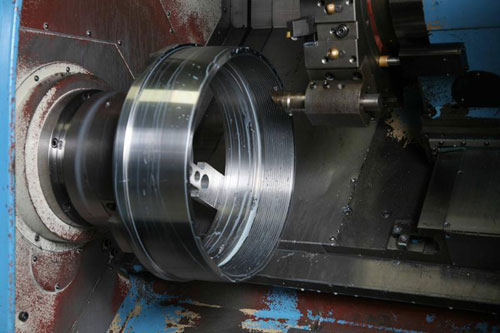D&E Machine has more than 40 years of experience machining parts for your industrial equipment. We can reverse engineer something, make a brand-new part to your specifications, and produce a rare part that you can’t order because it is no longer made.
One of the ways we do this is through CNC turning, a machining process that allows us to make precise and intricately detailed pieces.
Read on to see our answers to frequently asked questions about CNC turning.
What is CNC turning?
The process of CNC turning involves holding bars of material in a chuck, or gripping device that keeps the material firmly in place, and rotating the material at high speeds while a tool removes excess material to create the desired shape.
It’s also called “subtraction machining” because it involves the removal of material.
What does CNC mean in CNC turning?
Computer numerical control, which means a computer program guides the movement of the machine once the materials are in place.
What does a CNC turner do?
The machinist fastens the material firmly in the chuck. Material types, widths, and lengths vary. The more the material, the longer it may take to create the finished piece.
What is a CNC turning turret?
The turret, mounted on an arm that moves independently of the rotated material, can hold one or more tools. This method offers precise computer control. A turret can also take care of CNC milling through drilling holes, while etching tools can create markings. A tool that removes material is the most commonly used at the end of a turret.
What is the difference between CNC turning and CNC milling?
CNC turning allows a machinist to produce parts faster due to the rotational speed. CNC milling faces limitations based on the tools attached to the turret. Most modern CNC lathes can perform CNC turning and milling operations on a single piece and a single run.
What parts can be made by CNC turning?
This industrial process can produce a wide range of parts, including:
Automotive and industrial machinery parts that work in a heavy-duty environment.
Machinery components, microfluidic devices, logos, signage and printed circuit boards.
What materials are used in CNC turning?
CNC lathes can handle:
- Metals, such as steel, aluminum, and brass.
- Plastics, like acrylic, polycarbonates, polypropylene, and acetal.
- Wood for woodworking projects, including hardwood, softwood, and even plywood.
- Foam materials such as carving foam, rigid foam, and architectural foam.
What are the advantages of CNC turning?
When making custom parts, CNC turning offers the following benefits:
- Increased production speed for prototyping and low-volume runs.
- Enhanced production efficiency with computer control.
- Cost-effectiveness due to precision and scalability.
- Better safety for the machine operator and the workers utilizing the finished product.
Who can help me with CNC turning services?
The team at D&E Machine can prototype just about anything that can fit within the parameters of our CNC lathe.
Request a quote from us today, and we’ll get back to you as soon as we can.


